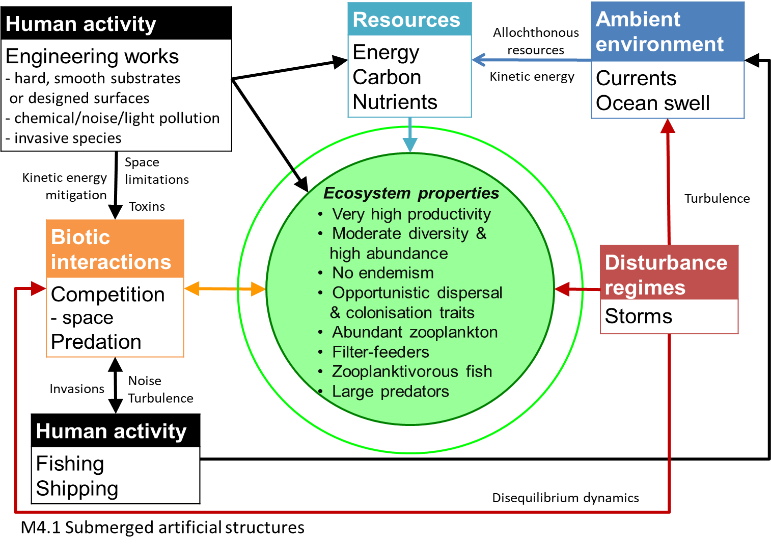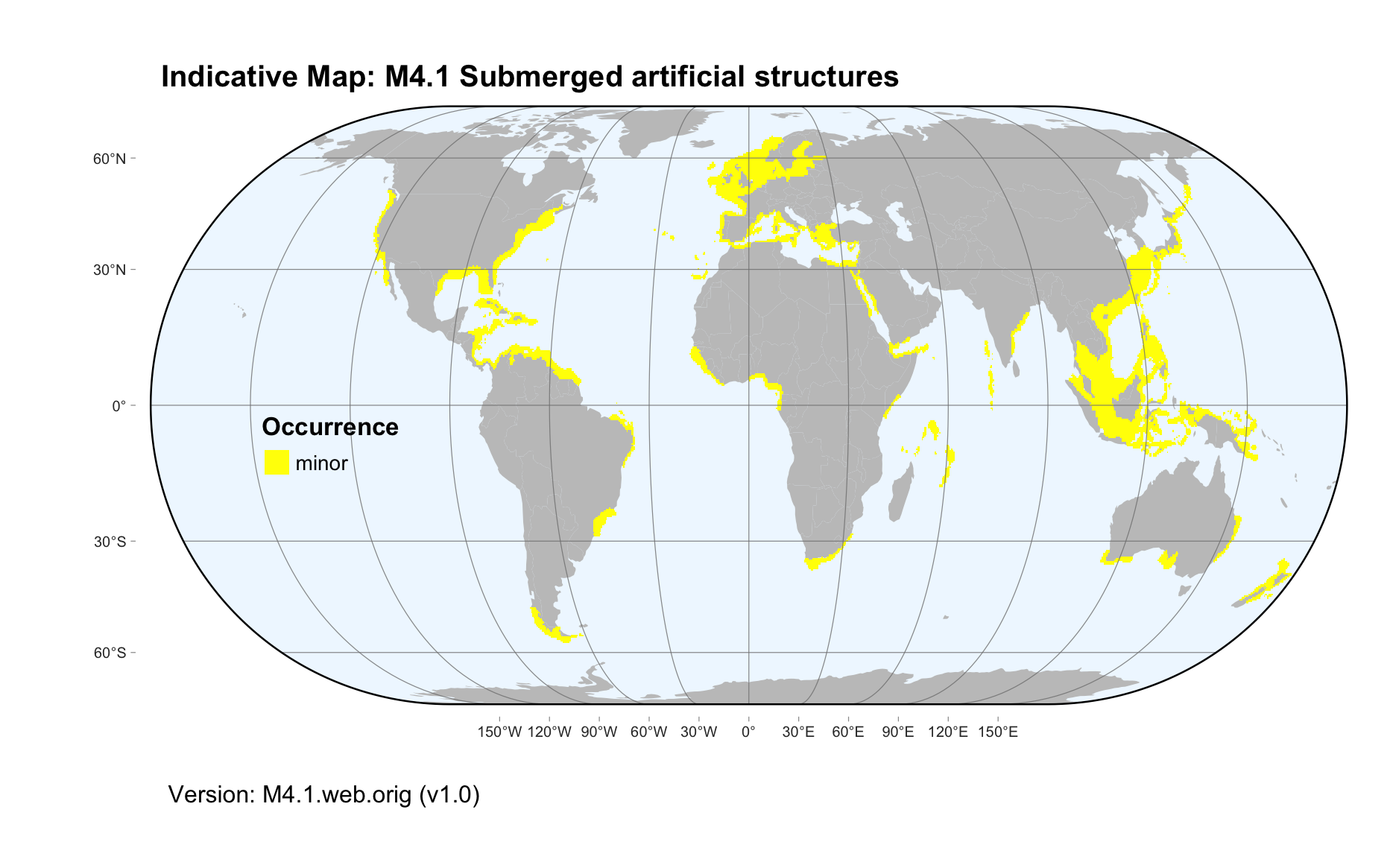Global ecosystem typology
Alternative site for the Global ecosystem typology with additional information for ecosystem profiles and indicative maps.
This site is maintained by jrfep
M4.1 Submerged artificial structures
Biome: M4. Anthropogenic marine biome
Contributors:
(texts)
Submerged structures, including rubble piles, ship wrecks, oil and gas infrastructure and artificial reefs provide vertically oriented hard substrates for marine organisms in coastal waters worldwide. Sedentary filter feeders like sponges and barnacles take advantage of access to plankton in ocean currents. Their excretions support high abundances of other invertebrates and fish, while organisms beneath the structures feed on nutrients falling to the bottom, particularly after storm events. Some types of structure increase exposure to light, noise and chemical pollution and may promote the spread of invasive species.
Key Features
Hard surfaces of oil and gas infrastructure, artificial reefs and wrecks form habitat for sessile filter feeders, invertebrates and some reef fish..
Overview of distribution
Coastal waters globally.
Profile versions
- v1.0 (2020-01-20): IM Suthers; DA Keith
- v2.0 (2020-06-15): IM Suthers; JT Claisse; TP Crowe; DA Keith
- v2.01 ():
- v2.1 (2022-04-06): IM Suthers; JT Claisse; TP Crowe; DA Keith Full profile available at official site
Main references
Selected references for this functional group:
Champion C, Suthers IM, Smith JA (2015) Zooplanktivory is a key process for fish production on a coastal artificial reef Marine Ecology Progress Series 541:1-14 DOI:10.3354/meps11529
Claisse JT, Pondella DJ, Love M, Zahn LA, Williams CM, Williams JP, Bull AS (2014) Oil platforms off California are among the most productive marine fish habitats globally Proc Natl Acad Sci. USA 111:15462–15467 DOI:10.1073/pnas.1411477111
Lima JS., Zalmo, R, Love M (2019) Overview and trends of ecological and socioeconomic research on artificial reefs Marine Environmental Research 145, 81-96
Scarborough Bull A, Love MS (2020) Worldwide oil and gas platform decommissioning: A review of practices and reefing options Ocean and Coastal Management 168, 274–306
Diagrammatic assembly model

Maps
Maps are indicative of global distribution patterns are not intended to represent fine-scale patterns. The maps show areas of the world containing major (coloured red) or minor occurrences (coloured yellow) of each ecosystem functional group. See general notes on maps.
There are 2 alternative versions of the indicative map for this functional group, please compare description and sources below.
M4.1.IM.orig_v1.0
Datasets
- Shipwrecks2004
- MEOW-2008
Map references
Rean Monfils (2005) The global risk of marine pollution from WWII shipwrecks: Examples from the Seven Seas International Oil Spill Conference Proceedings May 2005, Vol. 2005, No. 1, pp. 1049-1054. PDF from Sea Australia, Civic DOI:10.7901/2169-3358-2005-1-1049
Spalding MD, Fox HE, Allen GR, Davidson N, Ferdaña ZA, Finlayson M, Halpern BS, Jorge MA, Lombana A, Lourie SA, Martin KD, McManus E, Molnar J, Recchia CA, Robertson J (2007) Marine ecoregions of the world: a bioregionalization of coastal and shelf areas. Bioscience 57: 573–583. DOI:10.1641/B570707
M4.1.web.orig_v1.0

Datasets
- MEOW-2008
- Shipwrecks2004
Map references
Spalding MD, Fox HE, Allen GR, Davidson N, Ferdaña ZA, Finlayson M, Halpern BS, Jorge MA, Lombana A, Lourie SA, Martin KD, McManus E, Molnar J, Recchia CA, Robertson J (2007) Marine ecoregions of the world: a bioregionalization of coastal and shelf areas. Bioscience 57: 573–583. DOI:10.1641/B570707
Rean Monfils (2005) The global risk of marine pollution from WWII shipwrecks: Examples from the Seven Seas International Oil Spill Conference Proceedings May 2005, Vol. 2005, No. 1, pp. 1049-1054. PDF from Sea Australia, Civic DOI:10.7901/2169-3358-2005-1-1049
Check: the Glossary / Profile structure / the public document